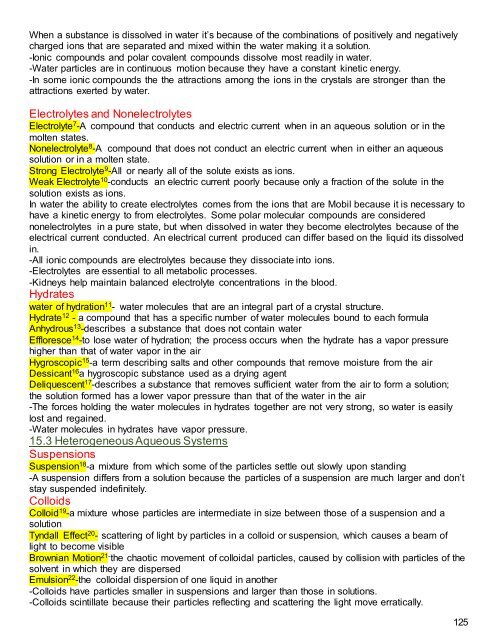You also want an ePaper? Increase the reach of your titles
YUMPU automatically turns print PDFs into web optimized ePapers that Google loves.
When a substance is dissolved in water it’s because of the combinations of positively and negatively<br />
charged ions that are separated and mixed within the water making it a solution.<br />
-Ionic compounds and polar covalent compounds dissolve most readily in water.<br />
-Water particles are in continuous motion because they have a constant kinetic energy.<br />
-In some ionic compounds the the attractions among the ions in the crystals are stronger than the<br />
attractions exerted by water.<br />
Electrolytes and Nonelectrolytes<br />
Electrolyte 7 -A compound that conducts and electric current when in an aqueous solution or in the<br />
molten states.<br />
Nonelectrolyte 8 -A compound that does not conduct an electric current when in either an aqueous<br />
solution or in a molten state.<br />
Strong Electrolyte 9 -All or nearly all of the solute exists as ions.<br />
Weak Electrolyte 10 -conducts an electric current poorly because only a fraction of the solute in the<br />
solution exists as ions.<br />
In water the ability to create electrolytes comes from the ions that are Mobil because it is necessary to<br />
have a kinetic energy to from electrolytes. Some polar molecular compounds are considered<br />
nonelectrolytes in a pure state, but when dissolved in water they become electrolytes because of the<br />
electrical current conducted. An electrical current produced can differ based on the liquid its dissolved<br />
in.<br />
-All ionic compounds are electrolytes because they dissociate into ions.<br />
-Electrolytes are essential to all metabolic processes.<br />
-Kidneys help maintain balanced electrolyte concentrations in the blood.<br />
Hydrates<br />
water of hydration 11 - water molecules that are an integral part of a crystal structure.<br />
Hydrate 12 - a compound that has a specific number of water molecules bound to each formula<br />
Anhydrous 13 -describes a substance that does not contain water<br />
Effloresce 14 -to lose water of hydration; the process occurs when the hydrate has a vapor pressure<br />
higher than that of water vapor in the air<br />
Hygroscopic 15 -a term describing salts and other compounds that remove moisture from the air<br />
Dessicant 16 a hygroscopic substance used as a drying agent<br />
Deliquescent 17 -describes a substance that removes sufficient water from the air to form a solution;<br />
the solution formed has a lower vapor pressure than that of the water in the air<br />
-The forces holding the water molecules in hydrates together are not very strong, so water is easily<br />
lost and regained.<br />
-Water molecules in hydrates have vapor pressure.<br />
15.3 Heterogeneous Aqueous Systems<br />
Suspensions<br />
Suspension 18 -a mixture from which some of the particles settle out slowly upon standing<br />
-A suspension differs from a solution because the particles of a suspension are much larger and don’t<br />
stay suspended indefinitely.<br />
Colloids<br />
Colloid 19 -a mixture whose particles are intermediate in size between those of a suspension and a<br />
solution<br />
Tyndall Effect 20 - scattering of light by particles in a colloid or suspension, which causes a beam of<br />
light to become visible<br />
Brownian Motion 21- the chaotic movement of colloidal particles, caused by collision with particles of the<br />
solvent in which they are dispersed<br />
Emulsion 22 -the colloidal dispersion of one liquid in another<br />
-Colloids have particles smaller in suspensions and larger than those in solutions.<br />
-Colloids scintillate because their particles reflecting and scattering the light move erratically.<br />
125



